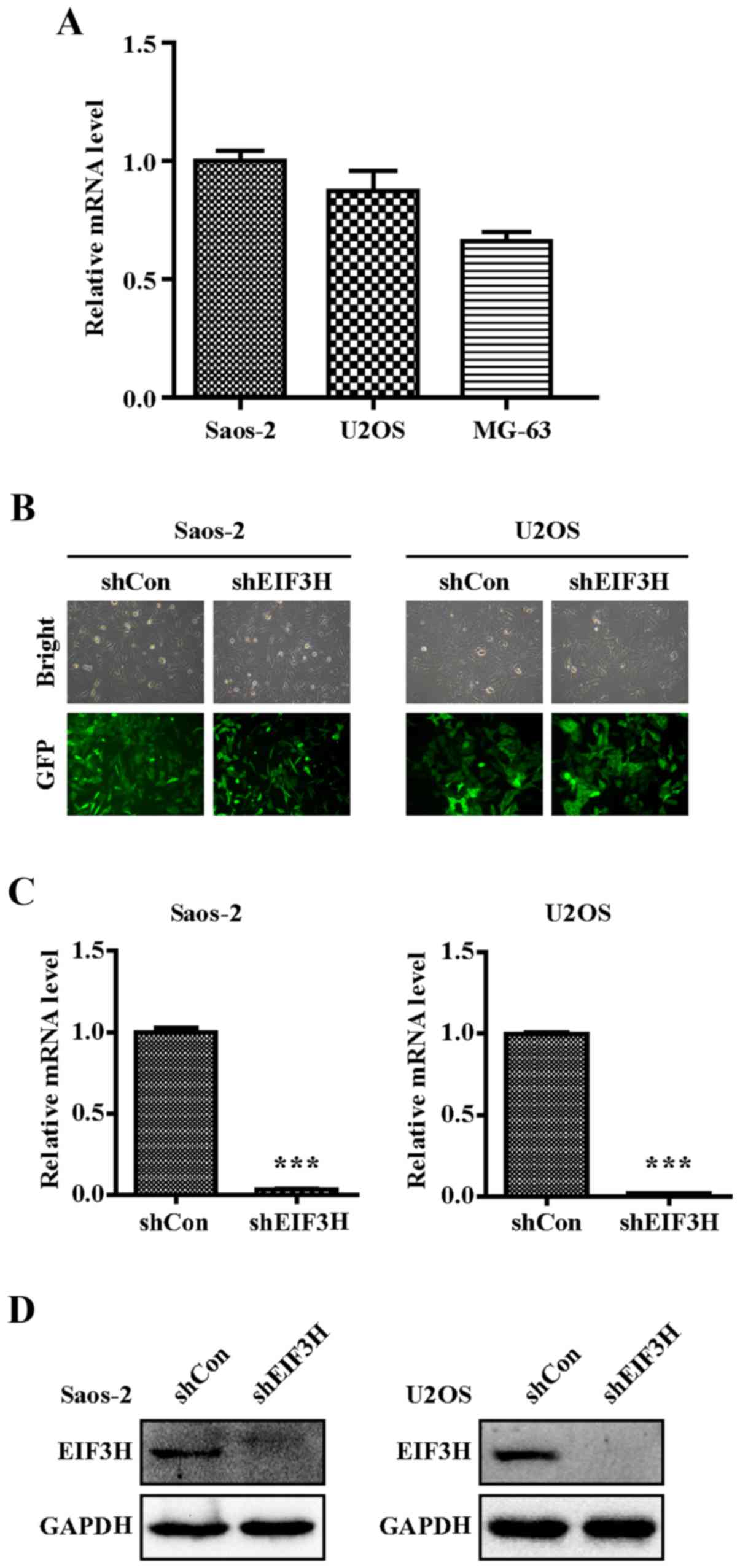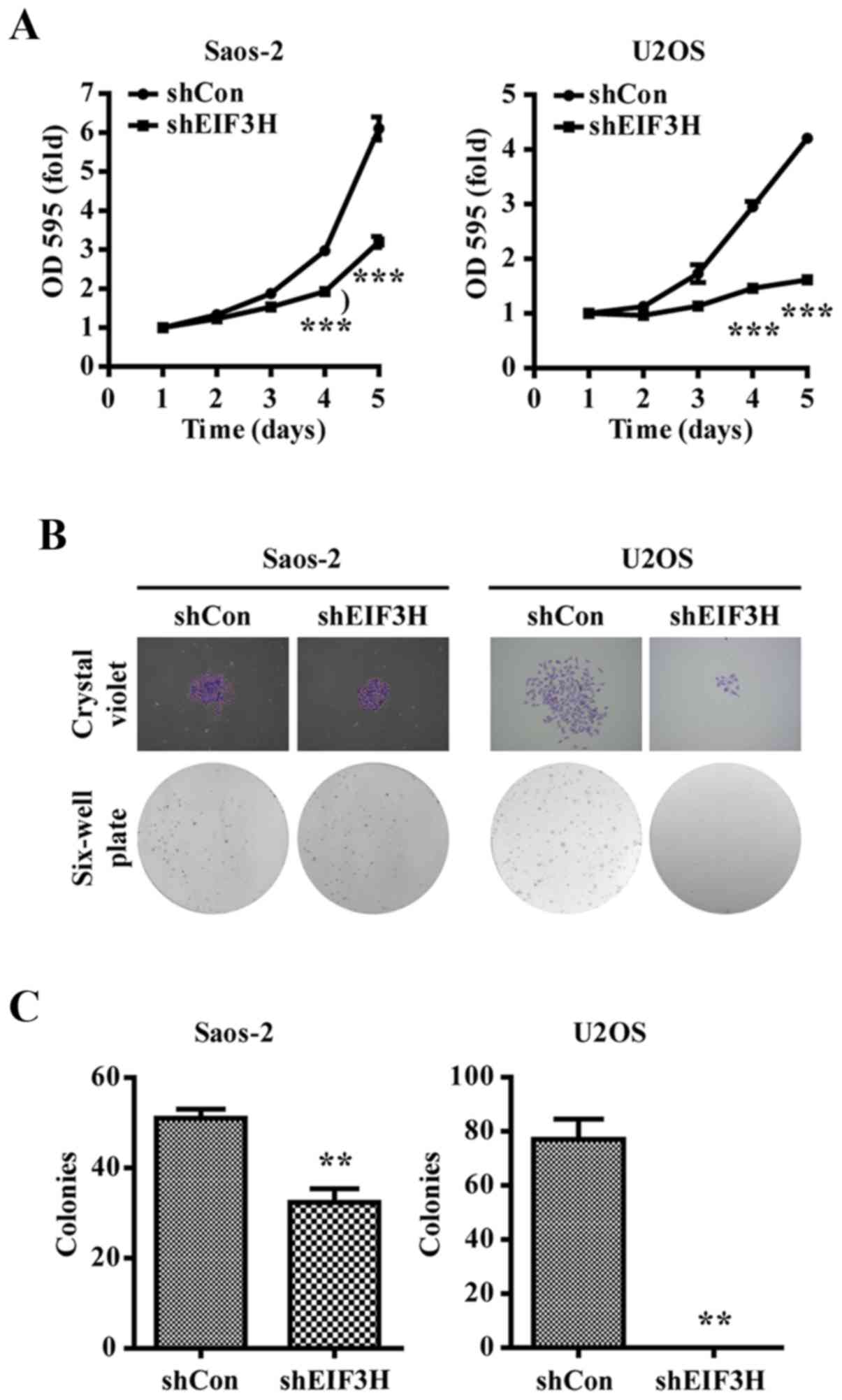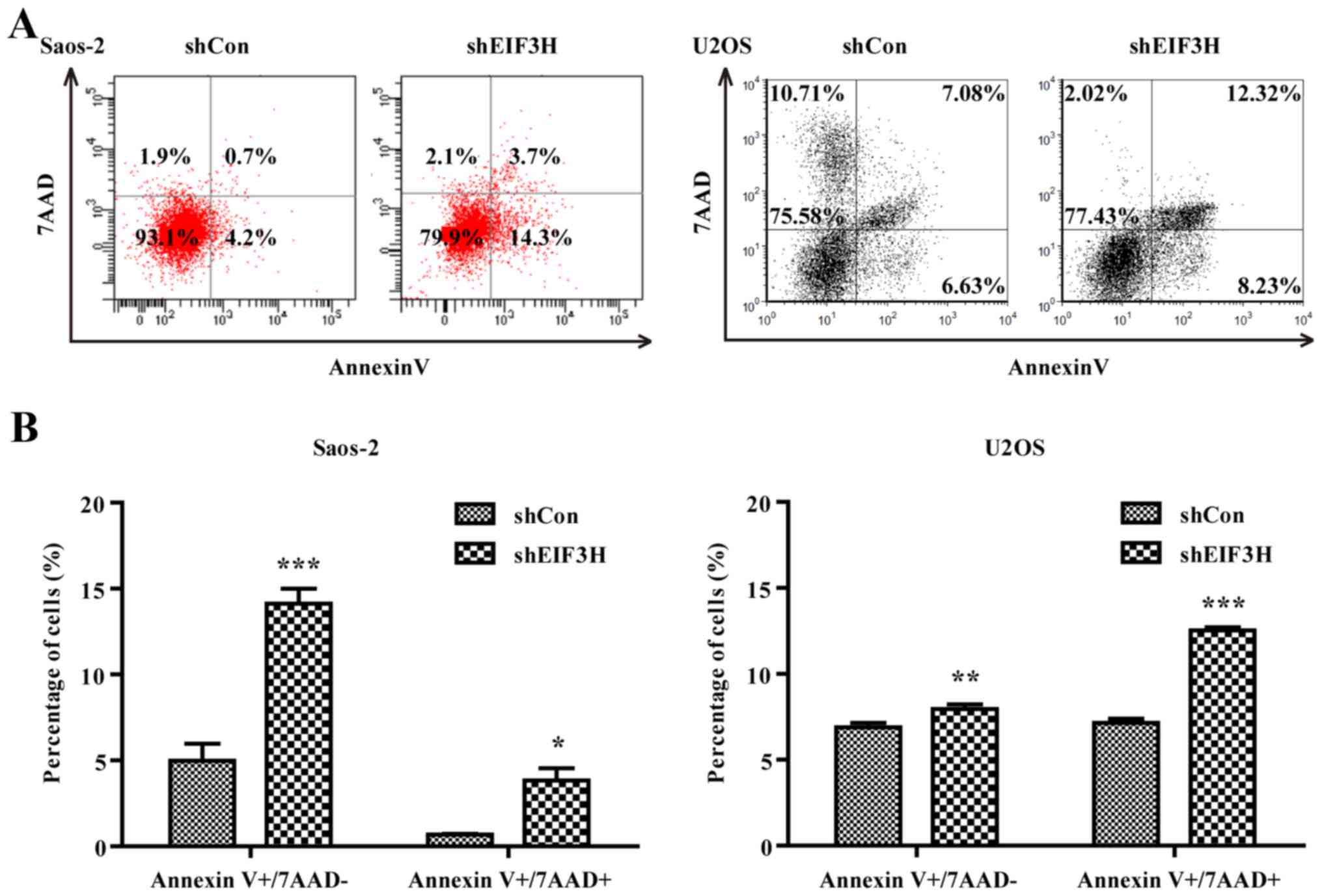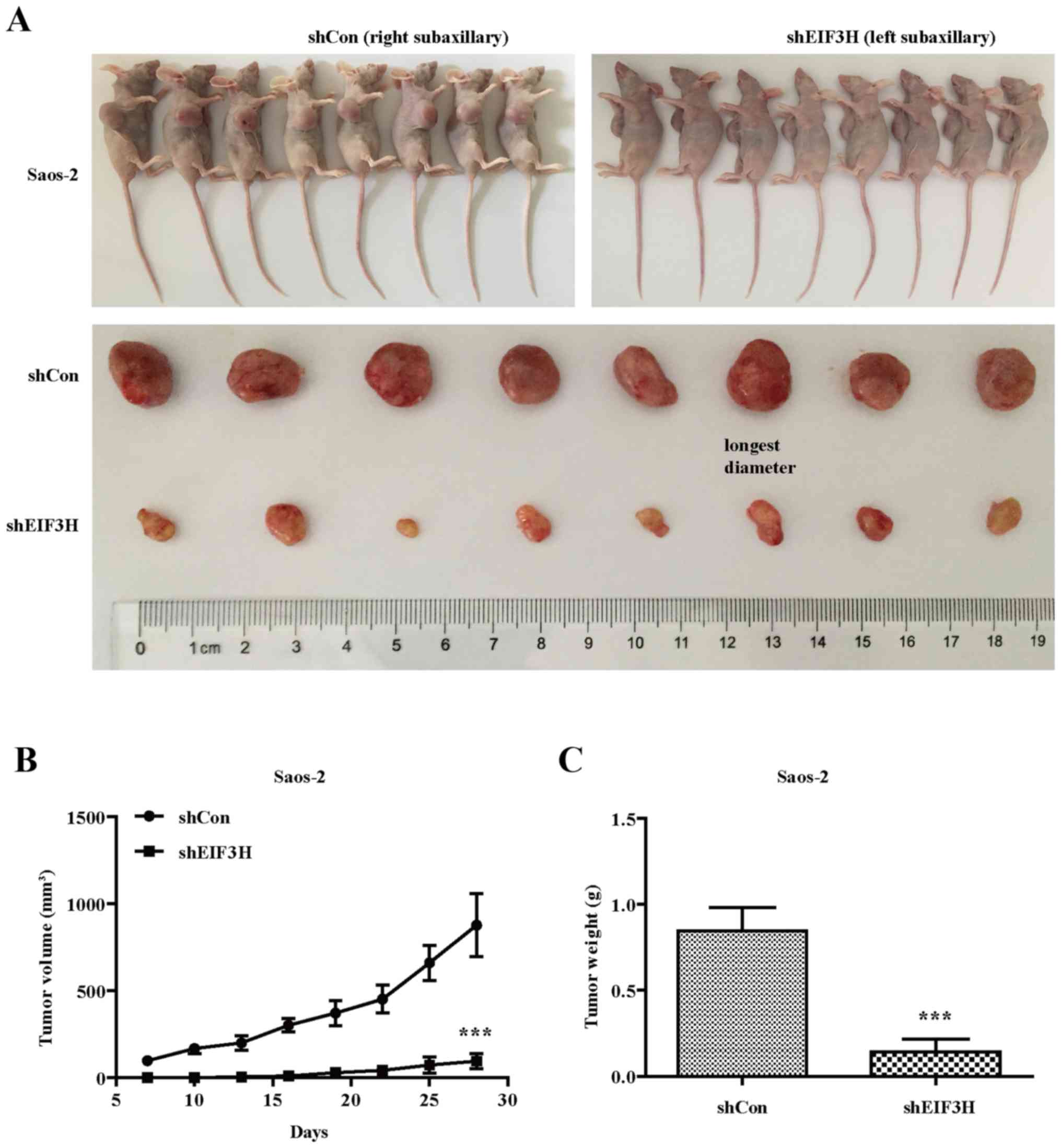Eukaryotic translation initiation factor 3H suppression inhibits osteocarcinoma cell growth and tumorigenesis
- Authors:
- Published online on: April 3, 2018 https://doi.org/10.3892/etm.2018.6031
- Pages: 4925-4931
-
Copyright: © Hong et al. This is an open access article distributed under the terms of Creative Commons Attribution License.
Abstract
Introduction
Human osteosarcoma (OS) is the most common primary malignant bone tumour that mainly occurs in children and adolescents. Conventional therapeutic approaches include treatment of disseminated disease with multi-agent cytotoxic chemotherapy, and local control of the primary lesion by chemotherapy or surgery. However, the 5-year survival rate of OS patients is only 60–70%, and there have been no improvements in this rate in the last 30 years (1,2), especially for patients showing metastasis at diagnosis (3). Consequently, there is a critical need to identify novel diagnostic markers and effective therapeutic targets for OS.
Eukaryotic translation initiation factor 3 (EIF3) is the largest of the translation initiation factors, comprising 13 non-identical protein subunits with a mass that is approximately 50% less than that of the 40S ribosomal subunit. One member of this family, EIF3H, plays a central role in translation initiation in higher eukaryotes and is located on chromosome 8q23 (4), a region frequently amplified in many tumour types (5,6). Recently, expression of the EIF3H gene was shown to be significantly upregulated in many human cancers (7,8). Knockdown of EIF3H could decrease cell viability through both cell cycle arrest and apoptosis induction and inhibited the formation of colonies in anchorage-independent conditions in breast cancer cells (7). Cappuzzo et al examined 54 metastatic NSCLC patients treated with gefitinib and found 10 cases (18.5%) showed amplification of EIF3H (8). These results indicated that EIF3H could play an important role in the growth and malignant phenotypes of cancer cells. However, the participation of EIF3H in human OS development and progression has been scarcely studied, and therefore its function in human OS is poorly understood.
To fill this knowledge gap and evaluate EIF3H as a candidate therapeutic or diagnostic target, we synthesized a sequence-specific interfering short hairpin RNA (shRNA) lentivirus targeting the EIF3H gene in OS cell lines to evaluate whether EIF3H could affect OS cell proliferation in vitro. MTT, cell cycle and apoptosis assay were selected to assess cell proliferation. In order to further verified this effect.
We investigated the potential role of EIF3H in OS by knocking down its expression in two OS cell lines, and evaluated the effects in vivo using an animal model.
Materials and methods
Cell culture
293T cells and the human OS cell lines Saos-2, U2OS and MG-63 were purchased from the Cell Bank of the Chinese Academy of Science (Shanghai, China). All cells were cultured in Dulbecco's minimum essential medium (HyClone; GE Healthcare Life Sciences, Logan, UT, USA) with 10% fetal bovine serum (Biowest, Riverside, MO, USA, 100 units/ml penicillin, and 100 mg/ml streptomycin at 37°C in a 5% CO2 atmosphere incubator.
Construction of the shRNA interference lentiviral vector
Two RNA interference sequences targeting EIF3H mRNA were designed and synthesized according to the EIF3H mRNA sequence in GenBank (NCBI accession no. NM_003756): EIF3H siRNA s1, 5′-GCAACTCTTGGAAGAAATATA-3′; EIF3H siRNA s2, 5′-CCCAAGGATCTCTCTCACTAA-3′. A random sequence was also designed to serve as a negative control (shCon). Sequences in the form of shRNA were inserted to a shRNA cloning and expression lentivirus vector containing green fluorescent protein (GFP)-tagged (SBI, Palo Alto, CA, USA). The lentivirus particles were produced in 293T cells transfected with the shRNA vector (shEIF3H) or the control (shCon) vector together with pHelper plasmids SHP001 (Sigma-Aldrich; Merck KGaA, Darmstadt, Germany).
Infection of cells by the lentivirus
Saos-2 and U2OS cells were seeded in 6-well plates at approximately 3×104 cells/well and 2.5×104 cells/well, respectively, and maintained in a 5% CO2 incubator at 37°C until reaching approximately 30% confluence. Saos-2 cells and U2OS cells were infected with the shEIF3H or shCon vectors at a multiplicity of infection of 40 and 20, respectively, according to the virus titre of the sequence. The medium was replaced after culturing for 16 h. Expression of the GFP reporter gene in lentivirus-infected cells was observed under a fluorescence microscope at 120 h post-infection.
RNA isolation and reverse transcription-quantitative polymerase chain reaction (RT-qPCR)
Total RNA was prepared from the human OS cell lines using TRIzol reagent (Invitrogen; Thermo Fisher Scientific, Inc., Waltham, MA, USA). First-strand cDNA was synthesized from total RNA with M-MLV reverse transcriptase (Promega, Madison, WI, USA) according to the manufacturer's instructions. RT-qPCR was performed using the SYBR-Green mix (Thermo Fisher Scientific, Inc.) on the Bio-Rad CFX96 sequence detection system. The primer sequences for the human EIF3H gene were: Forward 5′-GTGCTTTTGGGTCTGGTTGT-3′ and reverse 5′-ATACCAGCCCACGTGAAGAT-3′. The EIF3H gene expression levels obtained were normalized to the mRNA expression levels of actin, amplified with the following primers: Forward 5′-GTGGACATCCGCAAAGAC-3′ and reverse 5′-AAAGGGTGTAACGCAACTA-3′. The reaction conditions were as follows: a predenaturation step of 1 min at 95°C followed by 40 cycles at 95°C for 5 sec and 60°C for 20 sec. The melting curve was established under the following conditions: 95°C for 15 sec, 55°C for 30 sec, and 95°C for 15 sec. Each reaction was repeated three times per sample. The relative expression level of EIF3H was calculated using the comparative quantification cycle (Cq) method 2−ΔΔCq (9).
Western blot analysis
Cell lysates were prepared from Saos-2 and U2OS cells using 2X sodium dodecyl sulphate (SDS) Sample Buffer [100 mM Tris-HCl (pH 6.8), 10 mM ethylenediaminetetraacetic acid, 4% SDS, and 10% glycine]. Lysates were clarified by centrifugation at 13,000 × g for 5 min at 4°C, and the total protein was quantified by the bicinchoninic acid method and read at 560 nm. Protein samples were fractionated on 12% SDS-polyacrylamide gel electrophoresis gels and then transferred to polyvinylidene fluoride membranes (EMD Millipore, Billerica, MA, USA). The membranes were blocked with 5% non-fat milk for 1 h at room temperature and incubated with rabbit monoclonal anti-EIF3H antibody (1:500; Proteintech, Rosemont, IL, USA) followed by incubation with the secondary antibody horseradish peroxidase-conjugated goat anti-rabbit IgG (1:5,000; Santa Cruz Biotechnology, Inc., Santa Cruz, CA, USA). Bands were detected using enhanced chemiluminescence (ECL-PLUS/kit; Amersham Pharmacia Biotech, Tokyo, Japan) reagents. Anti-GAPDH antibody (1:500,000; Santa Cruz Biotechnology, Inc.) was used as the loading control.
Cell proliferation assays
The effect of EIF3H knockdown on cell proliferation was measured using 3-(4,5-dimethylthiazol-2-yl)-2,5-diphenyltetrazolium bromide (MTT; M2128; Sigma-Aldrich; Merck KGaA) plus acidic isopropanol. In brief, Saos-2 and U2OS cells were respectively seeded in 6-well plates at a density of 2×103 cells/well. At 24, 48, 72, 96, and 120 h after viral infection, MTT plus acidic isopropanol solution was added to each well and the plates were incubated at 37°C for 1 h. Absorbance values were determined at 450 nm on a microplate reader (Epoch; BioTek, Winooski, VT, USA).
Colony formation assays
For colony formation assays, Saos-2 and U2OS cells were plated on 6-well plates at 400 and 600 cells/well and cultured for 7 and 8 days, respectively, in a 5% CO2 incubator at 37°C (Thermo Fisher Scientific, Inc.). The colonies formed were washed with phosphate-buffered saline (PBS), fixed with methanol, and finally stained with 0.1% crystal violet solution (C0121; Beyotime Institute of Biotechnology, Haimen, China). The number of colonies containing 50 or more cells was counted under an inverted microscope (CKX41; Olympus, Tokyo, Japan). Each assay was repeated in triplicate.
Cell cycle analysis
For cell cycle analysis, Saos-2 and U2OS cells infected with shEIF3H or shCon were seeded in 6-cm dishes at 6×104 cells/dish and 8×104 cells/dish, respectively. After being cultured for 5 days, or until the cells reached approximately 80% confluence, the cells were stained with propidium iodide (Beyotime Institute of Biotechnology), and the cell cycle distribution was assayed on a Gallios flow cytometer (Beckman Coulter, Inc., Brea, CA, USA). The percentages of cells infected with ShEFI3H or shCon at the G0/G1, S, and G2/M phases were determined and compared. The experiments were performed in triplicate.
Flow cytometric analysis of apoptosis
The quantification of apoptotic cells was determined by flow cytometry using the Annexin V/7-AAD double staining kit (KGA1026; Nanjing KeyGen Biotech Co., Ltd., Nanjing, China) according to the manufacturer's instructions. In brief, Saos-2 cells and U2OS cells infected with ShRNA or shCon were seeded in 6-cm dishes at 6×104 cells/dish and 1.5×105 cells/dish, respectively. When the cells reached approximately 80% confluence, they were harvested, washed twice with PBS, and suspended in 450 µl binding buffer. Annexin V was added at room temperature, let to stand for 15 min for staining without light, and then resuspended in 450 µl binding buffer. The cells were then stained with 7-AAD in the dark. Cell apoptosis was analysed on a Gallios flow cytometer (Beckman Coulter, Inc.).
Xenograft tumorigenicity assay
Male BALB/c-Nude mice, 6–9 weeks old, were purchased from SLRC Laboratory Animal Company (Shanghai, China), and were housed under pathogen-free conditions in the barrier animal facility. For in vivo tumorigenicity experiments, Saos-2 cells stably infected with shCon or shEIF3H were collected, resuspended in PBS, and injected subcutaneously into the right or left subaxillary region of each mouse (2×104 per mouse), respectively. From the 7th day on, tumour xenografts were measured with callipers every 3 days, and tumour volume was calculated using the following formula: (length × width2) × 0.5. At the end of the experiments (day 28 post inoculation), the mice were anaesthetized with intraperitoneal injection of 100 mg/kg pentobarbital sodium, killed by cervical dislocation, and tumour xenografts were recovered and weighed. All animal experiments were approved by the Committee on the Ethics of Affiliated Hospital of Zunyi Medical College.
Statistical analysis
Student's t-test was performed using GraphPad Prism 5.0 software. Data are presented as the mean ± standard deviation. P<0.05 was considered to indicate a statistically significant difference.
Results
Infection efficiency of Saos-2 and U2OS cells with lentiviral vectors
Expression of EIF3H in four human OS cell lines were detected and results showed higher expression in Saos-2 and U2OS (Fig. 1A), which were selected for the next experiment. At 120 h post-infection with shEIF3H and shCon, both Saos-2 and U2OS cells showed strong expression of GFP, with an infection efficiency of over 80% in both cell lines (Fig. 1B), indicating that the lentiviral vector was successfully constructed to establish two stable cell lines.
shRNA effectively knocked down EIF3H mRNA expression
RT-qPCR analysis showed a 95% reduction in the EIF3H mRNA levels in both OS cell lines infected with shEIF3H compared to those infected with shCon (P<0.001; Fig. 1C). Western blot analysis further confirmed the efficacy of gene silencing, given a significant decrease in the relative protein expression level of EIF3H in the shEIF3H groups for both cell types (Fig. 1D).
EIF3H knockdown inhibited OS cell proliferation and colony formation
As shown in Fig. 2A, knockdown of endogenous EIF3H significantly inhibited the proliferation of Saos-2 and U2OS cells at 24, 48, 72, 96 and 120 h after viral infection.
Moreover, the number cells forming colonies was visibly reduced in the EIF3H knockdown groups compared to that in the shCon-infected groups, with a significant difference (P<0.01; Fig. 2B and C).
Knockdown of EIF3H led to cell cycle arrest and promoted apoptosis in OS cells
To investigate the potential mechanism of the inhibition of proliferation in the two OS cell lines, we assessed the effect of EIF3H knockdown on the cell cycle of OS cells by flow cytometry analysis. Both Saos-2 and U2OS cells with suppressed EIF3H expression significantly accumulated in the G0/G1 phase, whereas the percentages of cells in the S phase were significantly decreased compared to controls (P<0.05; Fig. 3A and B). These results indicated that EIF3H knockdown contributed to induction of G0/G1 arrest in OS cells.
As shown in Fig. 4A and B, EIF3H knockdown also increased the rate of apoptosis in the two OS cell lines based on flow cytometry using Annexin V and 7-AAD double-staining at both the early and late phases of apoptosis (Saos2 cells: 14.13 and 3.83% vs. 4.97 and 0.67% in controls, respectively, P<0.05; U2OS cells: 7.96 and 12.53% vs. 6.89 and 7.14% in controls, respectively, P<0.01).
EIF3H knockdown inhibited tumour growth in nude mice
Saos-2 cells infected with shEIF3H developed significantly smaller and reduced weighted tumors in mice compared to those infected with shCon (Fig. 5A), indicating that EIF3H knockdown also inhibited the growth of OS cells in vivo.
Discussion
OS is a malignant tumour that has become a global health issue. Although advances have been made in OS diagnosis and treatment, patient prognosis remains poor. We have demonstrated a clear role of EIF3H in the growth of OS cells and tumour development, suggesting a new candidate therapeutic target.
Over the past decade, the contribution of EIF3 to malignant transformation and progression has been established, and a previous study demonstrated that EIF3H expression was up-regulated in 18% of breast cancers and 30% of prostate cancers (10). Earlier studies also indicated that EIF3H was essential for maintaining the malignant state in cells (11). Zhu et al (12) reported that knockdown of EIF3H expression in hepatocellular carcinoma cells promoted apoptosis, and inhibited cell growth, colony formation, migration, as well as tumour growth in nude mice. In another study, reduction of EIF3H levels reduced cell proliferation and anchorage-independent growth in soft agar in breast and prostate cancer cell lines (13). However, the roles of EIF3H in human OS cells have thus far remained unclear, and there has been minimal research conducted on the effects of EIF3H in OS initiation and progression.
ShRNA-mediated gene silencing has proven to be a powerful tool to investigate the roles of cancer-related genes. Mahmood et al (7) demonstrated that EIF3H knockdown with specific small interfering RNA induced cell cycle arrest and apoptosis in breast tumour cells. We confirmed that an RNA interference strategy could effectively reduce the protein and gene expression of EIF3H in both OS cell lines as confirmed by western blot and RT-qPCR.
Moreover, knockdown of EIF3H markedly inhibited the growth and colony formation, resulted in G1 arrest, and induced apoptosis in Saos-2 and U2OS cells. The in vivo tumorigenicity experiments showed that EIF3H knockdown further inhibited the growth of xenograft OS tumours in vivo. Collectively, these results suggest that EIF3H may play an important role in OS, and that an EIF3H knockdown approach may be a potential therapy for the treatment of OS. Therefore, targeting EIF3H may provide a new tool for the clinical prevention and treatment of human OS.
Although we did not determine the mechanism by which high levels of EIF3H influence cell growth, previous studies have shown that dysregulation of protein synthesis is implicated in oncogenesis through influencing the mRNA levels of proteins involved in cell proliferation, which are translated with activation of the protein synthesis apparatus (14,15). Therefore, changing the translational apparatus elements or activity, particularly the initiation factors, may be an efficient strategy to modify protein synthesis (16,17), because the initiation phase is the rate-limiting step for the translation of most mRNAs (18). When EIF3H is overactivated, the translation of mRNAs related to malignancy would be disproportionately enhanced to contribute to malignant activity (19–21). Zhu and colleagues (12) identified that the transforming growth factor-beta and mitogen-activated protein kinase pathways are potentially targeted by EIF3H using microarray analysis. This mechanism along with others are worthy of further detailed investigation to establish a new therapeutic strategy for cancer.
In conclusion, our study provides the first demonstration that knockdown of EIF3H using shRNA technology could inhibit the growth and colony formation of two OS cell lines and further suppress the development of xenograft tumours. These findings suggest that knocking down EIF3H expression could become a novel therapeutic strategy for OS prevention and treatment.
Acknowledgements
The authors are thankful for the financial support from the Brainstorm Project on Social Development by Guizhou Province [no. QiankeheSY(2015)3046]. We would like to thank Editage (www.editage.co.kr) for English language editing.
Glossary
Abbreviations
Abbreviations:
|
EIF3H |
eukaryotic translation initiation factor 3H |
|
MTT |
3-(4,5-dimethylthiazol-2-yl)-2,5-diphenyltetrazolium bromide |
|
PBS |
phosphate-buffered saline |
|
RT-qPCR |
reverse transcription-quantitative polymerase chain reaction |
|
SDS |
sodium dodecyl sulphate |
|
shRNA |
short hairpin RNA |
|
OS |
osteocarcinoma |
|
GFP |
green fluorescent protein |
References
|
Isakoff MS, Bielack SS, Meltzer P and Gorlick R: Osteosarcoma: Current treatment and a collaborative pathway to success. J Clin Oncol. 33:3029–3127. 2015. View Article : Google Scholar : PubMed/NCBI | |
|
Gill J, Ahluwalia MK, Geller D and Gorlick R: New targets and approaches in osteosarcoma. Pharmacol Ther. 137:89–99. 2013. View Article : Google Scholar : PubMed/NCBI | |
|
Mirabello L, Troisi RJ and Savage SA: Osteosarcoma incidence and survival rates from 1973 to 2004: Data from the surveillance, epidemiology, and end results program. Cancer. 115:1531–1543. 2009. View Article : Google Scholar : PubMed/NCBI | |
|
Masutani M, Sonenberg N, Yokoyama S and Imataka H: Reconstitution reveals the functional core of mammalian eIF3. EMBO J. 26:3373–3383. 2007. View Article : Google Scholar : PubMed/NCBI | |
|
Rooney PH, Murray GI, Stevenson DA, Haites NE, Cassidy J and McLeod HL: Comparative genomic hybridization and chromosomal instability in solid tumours. Br J Cancer. 80:862–873. 1999. View Article : Google Scholar : PubMed/NCBI | |
|
Nupponen NN, Kakkola L, Koivisto P and Visakorpi T: Genetic alterations in hormone-refractory recurrent prostate carcinomas. Am J Pathol. 153:141–148. 1998. View Article : Google Scholar : PubMed/NCBI | |
|
Mahmood SF, Gruel N, Chapeaublanc E, Lescure A, Jones T, Reyal F, Vincent-Salomon A, Raynal V, Pierron G, Perez F, et al: A siRNA screen identifies RAD21, EIF3H, CHRAC1 and TANC2 as driver genes within the 8q23, 8q24.3 and 17q23 amplicons in breast cancer with effects on cell growth, survival and transformation. Carcinogenesis. 35:670–682. 2014. View Article : Google Scholar : PubMed/NCBI | |
|
Cappuzzo F, Varella-Garcia M, Rossi E, Gajapathy S, Valente M, Drabkin H and Gemmill R: MYC and EIF3H Coamplification significantly improve response and survival of non-small cell lung cancer patients (NSCLC) treated with gefitinib. J Thorac Oncol. 4:472–478. 2009. View Article : Google Scholar : PubMed/NCBI | |
|
Schefe JH, Lehmann KE, Buschmann IR, Unger T and Funke-Kaiser H: Quantitative real-time RT-PCR data analysis: Current concepts and the novel ‘gene expression's CT difference‘ formula. J Mol Med (Berl). 84:901–910. 2006. View Article : Google Scholar : PubMed/NCBI | |
|
Nupponen NN, Porkka K, Kakkola L, Tanner M, Persson K, Borg A, Isola J and Visakorpi T: Amplification and overexpression of p40 subunit of eukaryotic translation initiation factor 3 in breast and prostate cancer. Am J Pathol. 154:1777–1783. 1999. View Article : Google Scholar : PubMed/NCBI | |
|
Daxinger L, Oey H, Apedaile A, Sutton J, Ashe A and Whitelaw E: A forward genetic screen identifies eukaryotic translation initiation factor 3, subunit H (eIF3h), as an enhancer of variegation in the mouse. G3 (Bethesda). 2:1393–1396. 2012. View Article : Google Scholar : PubMed/NCBI | |
|
Zhu Q, Qiao GL, Zeng XC, Li Y, Yan JJ, Duan R and Du ZY: Elevated expression of eukaryotic translation initiation factor 3H is associated with proliferation, invasion and tumorigenicity in human hepatocellular carcinoma. Oncotarget. 7:49888–49901. 2016.PubMed/NCBI | |
|
Savinainen KJ, Helenius MA, Lehtonen HJ and Visakorpi T: Overexpression of EIFS3 promotes cancer cell growth. Prostate. 66:1144–1150. 2006. View Article : Google Scholar : PubMed/NCBI | |
|
Zhang L, Smit-McBride Z, Pan X, Rheinhardt J and Hershey JW: An oncogenic role for the phosphorylated h-subunit of human translation initiation factor eIF3. J Biol Chem. 283:24047–24060. 2008. View Article : Google Scholar : PubMed/NCBI | |
|
Choudhuri A, Maitra U and Evans T: Translation initiation factor eIF3h targets specific transcripts to polysomes during embryogenesis. Proc Natl Acad Sci USA. 110:9818–9823. 2013. View Article : Google Scholar : PubMed/NCBI | |
|
Ingolia NT, Ghaemmaghami S, Newman JR and Weissman JS: Genome-wide analysis in vivo of translation with nucleotide resolution using ribosome profiling. Science. 324:218–223. 2009. View Article : Google Scholar : PubMed/NCBI | |
|
Roy B, Vaughn JN, Kim BH, Zhou F, Gilchrist MA and Von Arnim AG: The h subunit of eIF3 promotes reinitiation competence during translation of mRNAs harboring upstream open reading frames. RNA. 16:748–761. 2010. View Article : Google Scholar : PubMed/NCBI | |
|
Spilka R, Ernst C, Mehta AK and Haybaeck J: Eukaryotic translation initiation factors in cancer development and progression. Cancer Lett. 340:9–21. 2013. View Article : Google Scholar : PubMed/NCBI | |
|
Graff JR and Zimmer SG: Translational control and metastatic progression: Enhanced activity of the mRNA cap-binding protein eIF-4E selectively enhances translation of metastasis-related mRNAs. Clin Exp Metastasis. 20:265–273. 2003. View Article : Google Scholar : PubMed/NCBI | |
|
Zimmer SG, DeBenedetti A and Graff JR: Translational control of malignancy: The mRNA cap-binding protein, eIF-4E, as a central regulator of tumor formation, growth, invasion and metastasis. Anticancer Res. 20:1343–1351. 2000.PubMed/NCBI | |
|
Kim BH, Cai X, Vaughn JN and von Arnim AG: On the functions of the h subunit of eukaryotic initiation factor 3 in late stages of translation initiation. Genome Biol. 8:R602007. View Article : Google Scholar : PubMed/NCBI |














